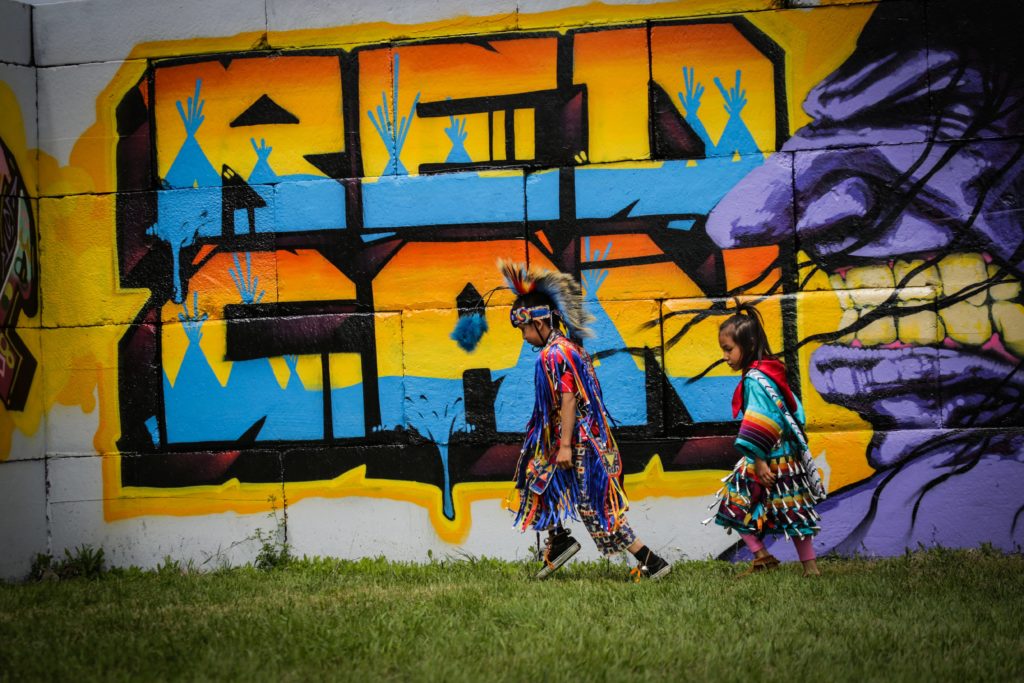Cheyenne River Youth Project
Cheyenne River Youth Project
“Graffiti is probably as controversial as Lakota culture is,” mused Julie Garreau, executive director of the Cheyenne River Youth Project (CRYP). “I thought that would get kids interested.” Looking for a way to engage teens living on South Dakota’s remote Cheyenne River Sioux Reservation, Garreau hired a graffiti artist to teach classes on spray-can control…
Location
Eagle Butte, South Dakota
Partners
Cheyenne River Youth Project
Public Funding Includes
National Endowment for the Arts: Our Town
National Endowment for the Arts: Art Works
National Endowment for the Arts: Challenge America
“Graffiti is probably as controversial as Lakota culture is,” mused Julie Garreau, executive director of the Cheyenne River Youth Project (CRYP). “I thought that would get kids interested.” Looking for a way to engage teens living on South Dakota’s remote Cheyenne River Sioux Reservation, Garreau hired a graffiti artist to teach classes on spray-can control and technique at the youth project’s Eagle Butte campus. Young people were indeed interested, and CRYP’s RedCan invitational graffiti jam was born in 2015.

Photos courtesy of Cheyenne River Youth Project
Now in its sixth year, RedCan is a major event in Eagle Butte, hosting renowned graffiti artists who teach skills in a variety of media and styles, create murals in CRYP’s Waniyetu Wowapi (Winter Count) Art Park and around the community, and encourage Lakota youth to express themselves and share their stories. Garreau explained, “We did have a lot of tagging in abandoned buildings, so it made a lot of sense that the kids CRYP serves might be interested in learning art skills through the medium of graffiti.” While CRYP had to do some early work to explain they weren’t teaching kids to vandalize, the community has grown to love RedCan. “They’re proud of it,” Garreau said. “It’s become this phenomenon across the country, that we have brought graffiti in such a different way to our community. I am loving that. At its heart, however, RedCan really is just another youth program – and we’ve let our kids lead the way.”
The National Endowment for the Arts awarded CRYP a 2015 Our Town grant to produce the first RedCan and build out youth programming around the event. The $100,000 award was CRYP’s largest grant to date and one of its first federal grants. Since then, Garreau has successfully applied for several other Arts Endowment awards, including Art Works and Challenge America grants as well as a second Our Town grant. These funds support the annual RedCan graffiti jam, local performances, traditional Lakota arts youth workshops and a youth arts internship program that has provided more than 600 teens with paid internships. In 2016, CRYP applied to ArtPlace America to develop its Waniyetu Wowapi Lakota Youth Arts and Culture Institute. That became the home for RedCan, the Waniyetu Wowapi Art Park and all of CRYP’s youth arts programming.

Photos courtesy of Cheyenne River Youth Project
CRYP raised money in its early days through sales of banana bread baked from donated bananas. Garreau now raises more than $1,000,000 annually from philanthropic, government and other sources. But she hasn’t relinquished that can-do attitude. “If we don’t have the money, we will find a way to do it,” she said. “For RedCan, it might mean having five or six artists come instead of 12, but we will always make the program happen.” That proved true in 2020, when COVID-19 forced CRYP, like so many others, to adapt. The organization produced RedCan 2020 virtually, broadcasting live from eight cities with art instruction, mural unveilings and short films.
These days, Garreau relies on her network of relationships with foundations and groups like Arts South Dakota and the South Dakota Arts Council to help her identify funding sources. “People are intrigued by this little nonprofit doing work in the middle of nowhere,” she said. “We have a really strong network of people who know the work we are doing, see the value and make sure we see opportunities.” She added that the diversity of CRYP’s programs – encompassing Native wellness, Native food sovereignty and security, social enterprise, education, and family services – opens a wide variety of funding doors.
She does not jump at every opportunity, however. “We are very careful about the kind of government funding we get,” Garreau said. “Early on, we did not enter into any government grants because they are difficult. They’re hard to manage, and you have to have so many systems in place.” She is particularly wary of establishing new programs for the sole purpose of winning government funding, preferring to match available resources to established programs that are already beneficial to the community. By the time CRYP applied for Our Town funding in 2015, she said, “We were ready for it. We had the systems in place, we had a good sense of where we were headed with the program, and we could apply for what we needed. We weren’t applying to create a program; it supported what we were already doing.”

Photos courtesy of Cheyenne River Youth Project
CRYP remains a relatively small organization. Garreau noted, “We can just do so much, so we have to be careful about what we take on. Sometimes the reporting can be overwhelming.” While she understands the need for statistical data, she believes the life stories of the people she serves are more critical to determining whether any grant was successful. Still, the discipline required to manage government grants has driven the organization to improve its data gathering in recent years, establishing a database to collect information Garreau and her staff use in pursuing a range of funding opportunities.
About a quarter of CRYP’s funding now comes from government sources. Garreau advised others seeking public funding, particularly younger organizations, to consider whether a given award will bring enough benefit to be worth the burden of compliance and reporting. She still examines potential opportunities closely and discusses with her staff whether each one is a good fit for CRYP. “You build and sustain programs that are good for your people,” she said, “then identify resources that fit those programs, and work to build the organizational capacity to use them.” Having progressed from selling banana bread long ago to compiling federal grant applications today, Garreau herself knows this for certain: “The time will come. It may not be now, but the time will come.”

